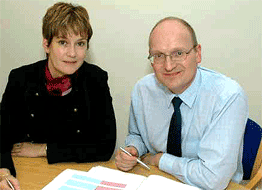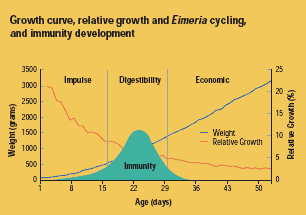Building on a good IDEA
Fine-tuning wheat-based rations together with coccidiosis vaccination gives producers in Northern Europe more flexibility.
 Rennie and ten Doeschate: 'Pretty unique challenges.' |
This four-pronged strategy "frequently called the IDEA concept for Impulse, Digestibility, Economy and Advance (see accompanying story) - makes good sense for almost any operation trying to wean itself from antibiotic growth promoters, which helped keep some enteric problems in check. The IDEA concept has proved to be particularly beneficial where a vaccine is used instead of an in-feed coccidiostat to control coccidiosis because producers don't have to work around the coccidiostats in the feed.
"In traditional anticoccidial programs, you have to build your nutrition program around the rotation schedules and withdrawal times," explains Dr. John Radu, a veterinarian and worldwide technical service manager for Schering-Plough Animal Health. "When you vaccinate for coccidiosis, you don't have those restrictions. You can tailor the nutrition program to meet the needs of the birds at a specific age, not the timetable for the coccidiostat program. The result is often a better nourished and healthier flock, one that might get by on lower cost rations in the final phases."
Comparing nutritional requirements
Dr. Rob ten Doeschate, a poultry nutritionist at Abnatech Global, Peterborough, England, believes the nutritional requirements of vaccinated and medicated birds shouldn't have to be any different. They're the same birds with the same nutritional requirements, he argues. They also have similar challenges from coccidiosis."Because at the end of the day, both types of birds should have a minimal coccidiosis challenge," he says. "We do know that a vaccinated bird at certain stages has to cope with a bit of a controlled challenge caused by the oocysts in the vaccine. But at the same time, birds on a standard in-feed anticoccidial program are often faced with a similar and perhaps less predictable challenge because the coccidiostats don't provide 100% control. Lesion scoring tends to be about the same for both groups."
He notes that field strains of Eimeria organisms that cause coccidiosis are developing resistance to in-feed anticoccidials. "And we're seeing a lot more of that in recent years because there are even fewer in-feed products available to rotate," he says. "When every poultry company is on the same rotation, there's nothing to compare it to and no one knows if one company's program is doing better than the other. The reality is that this background challenge could be quite high even in birds on coccidiostats and we just don't realize it."
Ten Doeschate agrees with the principles of IDEA. However, in Northern Europe and other areas with cooler, damper environments, he thinks producers might actually have an easier time embracing the IDEA concept - for the simple reason that they've had to practice it all along.
"We have some pretty unique challenges in the UK," he says. "We're raising birds in less than ideal economic conditions, where investment is difficult, land prices are high and building is expensive.
Adapting IDEA to Northern EuropeSchering-Plough Animal Health devised the IDEA concept to help birds vaccinated against coccidiosis achieve their performance potential.For the UK and other northern markets, however, the IDEA concept needs some refining because some aspects of the concept are already routine practice in this market. "The majority of the market is already using very high specification starter diets, at or above breed standards," notes Dr. Sarah Rennie, technical business manager for Schering-Plough Animal Health in the UK. Working with Dr. Rob ten Doeschate at Abnatech Global, Rennie set up a trial to investigate the Digestibility and Economy phases of the IDEA concept. Good gut integrity"During the grower period, maintaining good gut integrity and efficient digestion is not easy to achieve, especially in the absence of antibiotic growth promoters and in-feed anticoccidials," she explains."We wanted to investigate whether adding betaine and adjusting the amino acid profile during the grower phase would have an impact on performance. We also wanted to see if not changing the diet during the critical 13- to 27-day period helps maintain gut integrity." According to the IDEA concept, vaccinated birds should be able to utilize lower cost final diets better than medicated birds, which was the last factor to be investigated in this trial. In their 64-pen trial, they had 25 male and 25 female Ross 308 broilers per pen. Basal diets were formulated to current UK nutritional standards. Trial diets were supplemented with up to 10% whole wheat, reflecting current on-farm practice in the UK. Coccidiosis was controlled by either vaccinating day-old chicks with Paracox-5 or with a combination of in-feed anticoccidials "nicarbazin and narasin from 1 to 12 days, and monensin in the grower (13 to 27 days) and finisher (28 to 35 days). They wanted to determine whether the following would impact performance:
Cutting costs possibleThe results suggest that in Northern Europe, there is no performance benefit from enhancing the starter diets or cutting the number of grower diets from two to one in vaccinated birds. Furthermore, using a lower spec final feed in vaccinated birds did not affect liveweight or feed conversion."This indicates that cutting costs at this phase may be possible," Rennie adds. They concluded that using Paracox-5 in broilers fed good quality basal rations is not associated with a drop in performance and dietary enhancement is not needed. Further work is needed to determine how much producers can take advantage of the vaccinated birds' improved status, which in this case allowed a reduction in concentration of certain essential amino acids in the final feed without hurting performance. The full scope of the study and additional insights on the results will be presented at the European Poultry Conference in Verona, Italy, September 10-14. |
"Then you have the issue of our weather, which is legendary," he continues. "It's generally much cooler here than in southern Europe. And as everyone knows, we get a lot of rain. That creates more problems maintaining the litter, which can become a fertile breeding ground for coccidial oocysts."
Working around wheat
Feedstuffs also present a challenge. Like their counterparts in other areas of Northern Europe, producers in the UK feed 100% wheat-based diets. Besides being coarser in texture and rougher on the intestinal wall than diets incorporating maize, the resulting digesta also have high viscosity, which favors the growth of the undesirable bacteria that cause enteritis."We use enzymes to combat that, but even with enzymes we have higher viscosity than you would have with maize-based diets," he explains. The absence of antibiotic growth promoters, which in the past had some effect on enteric disease and helped to make up for any shortcomings in management, presents another challenge to producers.
While many poultry operations in the EU are still adapting to the January 1 ban on such products, ten Doeschate says UK producers have pretty much done without them since 1998, when all the major UK supermarket chains instituted a ban of their own.
Overcoming adversity
His point is that UK poultry producers are used to facing all sorts of economic, environmental and political adversity. As a result, they've had to become highly resourceful and more cognizant of maintaining good intestinal health to fight disease and enhance performance, he says.The principles of IDEA are already in place. With more operations turning to coccidiosis vaccination and pulling anticoccidials from their feed, ten Doeschate is hoping to take advantage of this newfound flexibility and make further refinements to their programs. "When I first saw the IDEA concept, it wasn't really new to me because we were already following most of its principles," he says. "My challenge is optimizing feed conversion, health and ultimately on the amount of money the grower makes."
"We don't mind spending a bit of money on the starter diet because you only feed a small amount to the birds," he continues. "The grower is quite happy to pay £5 a tonne more (over a £160 per tonne average) if he can see a penny a bird more profit. We're already in the habit of getting birds off to a good start. If you're already using a high-spec starter diet, you can't really improve much on it."
He notes that in some parts of Europe, producers have used sodium to boost feed intake in the starter. "But that's not an option here because sodium also encourages birds to drink more water," he says. "And when they drink more water, you get more water coming out the other end "and that creates problems for litter quality and bird welfare."
Making good rations better
Ten Doeschate initially targeted the Digestibility phase of the IDEA concept "approximately 13 to 27 days "to see if further improvements could be made there and whether changing feed ingredients would have any negative impact on the performance of vaccinated birds during the period of high oocyst replication. (See accompanying story.)His next focus is the Economic phase, or about 28 days to market weight. Because vaccinated birds grown on the principles of IDEA should have better immunity and gut health, there's room to economize on the diets in the final phase without compromising performance or returns.
"Going from 28 or 30 days to a market age of around 50 days for the males is quite a long period in the lifetime of the birds," he says. "Is it desirable to keep birds on the same feed for 20 days? From a nutritional standpoint, it might be possible in that period to have more than one feed. As the birds get older, you could reduce the amino acid levels and improve profitability. If you were feeding 45-day-old pullets on the final feed we use in the broilers we're using at the moment, you would argue that you're overfeeding protein."
Not having a coccidiostat in the feed also helps operations remain more flexible when thinning females from their flocks, usually somewhere between 33 to 40 days. The vaccine provides lifelong protection, so producers don't have to worry about withdrawal times or leaving the males unprotected for longer periods.
"To be fair, all of the nutritional knowledge we have was developed in medicated birds," ten Doeschate concludes. "I look back on our trial database, and it's all birds that had anticoccidials in their feed. When producers are vaccinating for coccidiosis, there's so much more to look at and hopefully new opportunities at hand. We have to keep the end goal in sight, which is maintaining litter quality and profitable production."
"But every country is different," he adds. "Every country has different challenges and different economics. We can't make a blueprint, but the principles are universal."
What's the big IDEA? By adapting nutrition programs to the physiological situation
in the intestine of vaccinated birds and matching
nutrient needs to the building of immunity
in each period, vaccinated birds
will perform better. This is spelled out in
the IDEA concept:
By adapting nutrition programs to the physiological situation
in the intestine of vaccinated birds and matching
nutrient needs to the building of immunity
in each period, vaccinated birds
will perform better. This is spelled out in
the IDEA concept:I: Impulse phase. Prepare the immune system and intestinal cells for the development of immunity against coccidiosis; at the same time, get the birds off to a good start. D: Digestibility phase. Help the immune system and intestinal cells build immunity. This is important not only for coccidiosis, but also because most intestinal infectious problems and disturbances occur in this period. E: Economy phase. Take advantage of birds' immunity against coccidiosis with good intestinal health. A: IDEA enables an Advance in poultry farming and is a good alternative for the new era when in-feed additives will no longer be available. |
Source: CocciForum Issue No.12, Schering-Plough Animal Health.







